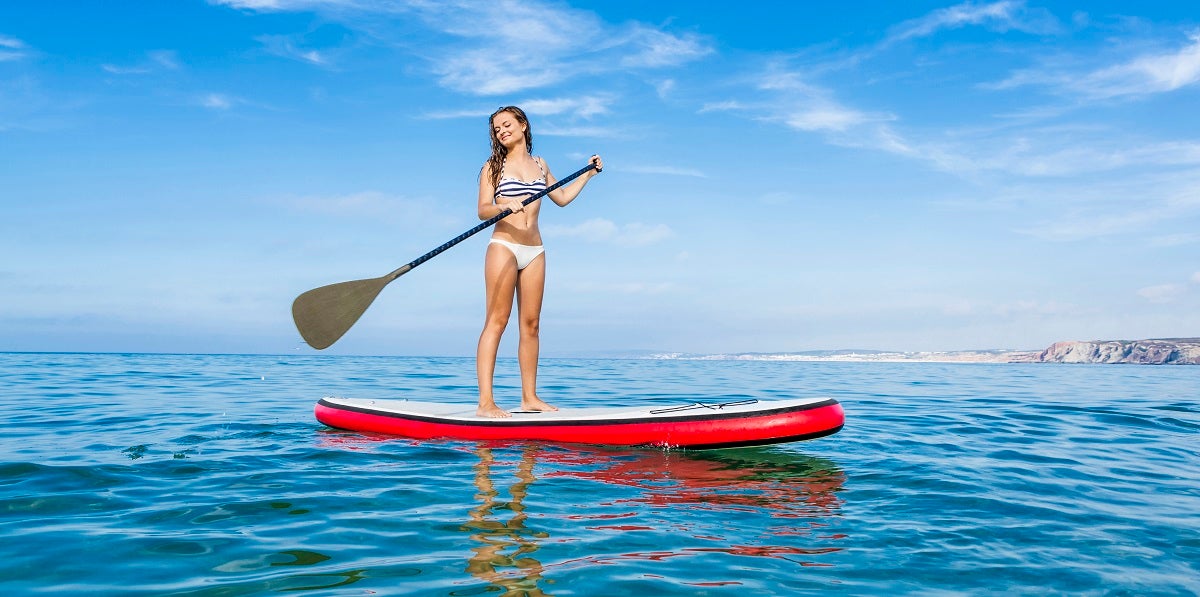
Our Editors independently research, test, and rate what we feel are the best products. We use affiliate links and may receive a small commission on purchases.
Many people avoid inflatable standup paddle boards (SUPs) because they have many incorrect ideas about them. Sure, most inflatable items we use on the water come in the form of a shark or donut, but inflatable SUPs are made with a much higher level of quality.
To go a bit more in-depth and ensure you make the right decision on which paddle board to get, we’re going to cover 7 of the biggest myths about inflatable stand up paddle boards.
#1: Inflatable SUPs are Made with Cheap Materials
Just because it’s inflatable doesn’t mean it’s cheap. In fact, most quality inflatable stand up paddle boards are made using super-strong PVC material with cross stitching. Some are even comprised of military-grade materials that are meant to take a beating. You may even see certain models that are made with two layers of PVC to further add to the sturdiness of the construction.
The key here is to ensure it’s inflated to the correct pressure. When done properly, you can even count on inflatable models lasting longer and retaining their form better than rigid boards. You don’t have to worry about them chipping or shattering.
#2: Inflatables are for Beginners Only
While inflatables can be an excellent choice for newbies, they’re also great for many paddlers of more advanced levels. This goes double if you’re planning on solely taking your board out on lakes, mildly choppy waters, etc. If you’re going to be traveling long distances in rougher white waters, however, you’ll probably want to opt for a rigid paddle board.
If you’re a more advanced paddler and have yet to try an inflatable board, give one a go! We’re sure you’ll like what you experience.
#3: Inflatables are a Hassle to Inflate
Actually, this couldn’t be further from the truth but we can understand why someone would think that if they’ve never owned one before. Most inflatable SUPs will come with either a hand pump or an electric pump for you to connect and start filling it up. You shouldn’t expect this process to take longer than 5 minutes, and that would probably be with a hand pump as electrics are even quicker.
Once it’s reaches the ideal PSI for that particular model, simply close the valve and you’re ready to go! However, even with this added step of inflation, it still takes longer to unpack and get in the water with a rigid board than an inflatable.
Why?
Because you don’t have to worry about hooking up and strapping in (and unstrapping it once you reach your destination) your rigid SUP to the roof of your vehicle, nor drive slower to ensure it stays in place.
4: They’re Harder to Repair Than Rigid Boards
If you’ve damaged your rigid board, your best bet is to take it to a pro to have them repair it. As they use a special epoxy, even a small dig can negatively affect your riding experience. In contrast, inflatables won’t ding or dent. While tearing of the PVC is a possibility, it’s actually quite the rarity in SUPing.
Moreover, any quality model will come with a repair kit and you generally won’t have to take it to a professional to fix tears or leaks. This will save you both time and money!
For this reason, inflatables are actually known to be more durable than hard paddle boards! If you happen to drop it on the ground or bump it against a tree, it’s going to be just fine. Do the same with a rigid alternative and you’ll have to take it to get fixed. That is, if it hasn’t shattered completely.
#5: Inflatables Simply Aren’t Designed for High Performance
Okay, this one isn’t really a black-and-white answer. While hard paddle boards are generally faster and offer a bit more momentum overall, the difference between a rigid and an inflatable SUP are almost never more than 5%. Are you even going to notice that difference? It’s likely that you won’t.
You may have a slightly smoother ride but you can also go fishing or do yoga on an inflatable. Pretty much anything you want to do on a rigid SUP, you can do on an inflatable.
#6: Inflatable SUPs are Expensive
Of course, this depends on your definition of expensive but when compared to a rigid stand up paddle board, absolutely not. In fact, you can typically score an inflatable for a few hundred dollars less than a rigid SUP! Not only that, but you’re saving an incredible amount of time not having to strap it to your roof and you don’t have to worry about storage space.
#7: Inflatable Paddle Boards Shouldn’t Be Used on the Ocean
While inflatable boards work great on calmer waters like lakes and lazy rivers, you’re not limited to only those bodies of water. While we don’t recommend them to be used in incredibly choppy waters caused by boat traffic and whatnot, they are definitely capable of taking on oceans too. Just make sure that you’re rinsing it with fresh water after every use.
Summary
Now that you know the truth about inflatable stand up paddle boards, what have you decided to get? While rigid boards definitely have their place in the sport, we encourage you to not look over an inflatable model. They will be sure to last you a long time and if you tend to bump into things or drop things often, you’ll love how well they hold up against dings and tears.
We hope that our guide has helped you to pick the best type of SUP for you and that you’re ready to get out on the water. Thanks for tuning in, and we’ll see you again soon!
